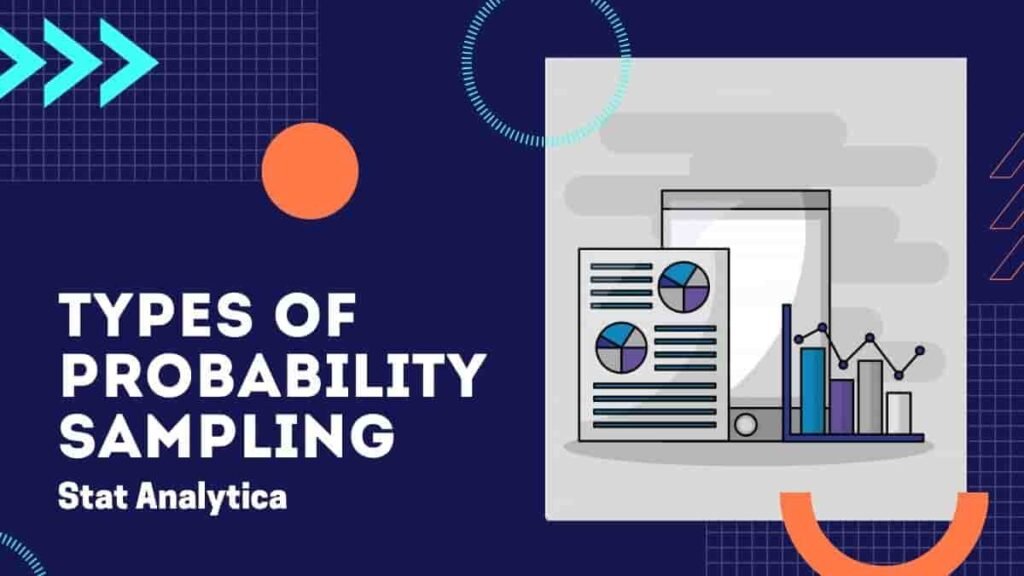Probability sampling is a sampling technique in which a researcher uses a tool based on probability theory to select samples from a larger population. If a person is to be considered a probability sample, he or she must be chosen at random.
The essential requirement for probability sampling is that everybody in your population has an equal chance of getting selected. For example, in a population of 100 people, each person has a one-in-a-hundred chance of getting selected. Probability sampling provides the greatest opportunity for obtaining a sample that is truly representative of the population.
Probability sampling uses statistical theory to pick a small number of people (sample) at random from a large population and then predict that all of their responses will represent the entire population.
What are the types of probability sampling?
Table of Contents
There are four types of probability sampling:
- Simple random sampling
- Stratified random sampling
- Random cluster sampling
- Systematic sampling
Simple random sampling:
As the title suggests, simple random sampling is a completely random method of selecting the sample. This sampling method is as simple as assigning numbers to individuals (sample) and then selecting numbers randomly using an automated procedure. Finally, the participants in the sample are represented by the numbers selected.
In this sampling method, researchers select samples using two methods: the lottery system and number generation software/random number table. This sampling method is typically used on a large population and has several benefits and drawbacks.
Stratified random sampling:
Stratified random sampling is a technique in which a researcher divides a larger population into smaller groups that don’t overlap but still represent the entire population. Organize these groups while sampling, and then take a sample from each group separately.
Organizing or classifying by sex, age, ethnicity, and other factors is a common practice. Subjects are divided into mutually exclusive groups, and members are selected from each group using simple random sampling.
Members of these groups should be distinct enough that everyone in each group has an equal chance of being selected using simple probability. This approach is also known as “random quota sampling.”
Random cluster sampling:
Random cluster sampling is a technique for selecting participants that are geographically dispersed at random. For example, getting a full list of everybody in the united states would be difficult if you were to pick 100 people from the entire population. Instead, the researcher picks areas (cities or counties) randomly and then picks from within those boundaries at random.
Cluster sampling is used to examine a population in which the sample contains more than a few elements such as a neighborhood, a family, a university, and so on. The clusters are then selected by splitting the population into smaller groups.
Systematic sampling:
When you use systematic sampling, you choose every “nth” individual to be included in the survey. For example, you may include every fifth individual in the survey. Systematic sampling is a more advanced version of the same old probability method, in which each member of the group is randomly selected to form a sample at regular intervals. Using this sampling method, every member of a population has an equal chance of being selected. these are the types of probability sampling.
Advantages and disadvantages of probability sampling
Each probability sampling technique has its own set of benefits and drawbacks. In general, probability sampling reduced the chance of systemic bias. This ensures that the findings are reflective of the population by reducing the chance of over-or-under representation.
Probability sampling also allows you to verify your findings using statistical methods such as confidence intervals and margins of error.
Advantages of probability sampling
- Cluster sampling: easy to use and convenience
- Simple random sampling: ensure that samples are highly representative of the population.
- Stratified random sampling creates strata or layers that are highly representative of population strata or layers.
- Systematic sampling: Without using a random number generator, it generates samples that are highly representative of the population.
Advantages of probability sampling
- Cluster sampling: If the unit members are not homogeneous, they will not function well (i.e., if they are different from each other).
- Simple random sampling: it’s time-consuming and repetitive, particularly when working with larger samples.
- Stratified random sampling: it’s time-consuming and repetitive, particularly when working with larger samples.
- Systematic sampling: this method is not as random as simple random sampling.
What is the example of probability sampling?
Let’s get a look at an example to understand better how this sampling technique works. The United States has a population of 330 million people. It is almost impossible to give a survey to every single person to collect data. And if you’re collecting data from a small population, use probability sampling.
For example, consider a company with 500,00 employees spread across the globe. The company wants to make some changes to its human resource policies, but they want to know if the workers will be satisfied with the changes before they implement them. On the other hand, reaching out to all 500,000 workers is a time-consuming job. Probability sampling comes in handy in this situation. A random selection of 500,000 workers is selected from the wider population. This survey will represent the population. Now is the time to send out a survey to the sample.
Management will also determine whether or not workers of that company are pleased with the amendment based on the feedback obtained.
What are the steps in a probability sampling procedure?
Follow these steps to perform probability sampling:
- Carefully choose your population of interest: think carefully and select from the community you feel should have their views gathered, and then include them in the survey.
- Choose an appropriate sample frame: to gather reliable data, your sample frame should include a sample from your target population and no outsiders.
- Choose your sample and begin your survey: finding the correct sample and determining an appropriate sample frame can be difficult at times. Even if all of the odds are in your favor, there will be unexpected issues such as cost, quality of respondents, and response time. It may be difficult, but not impossible, to get a sample to answer correctly to a probability survey.
However, drawing a probability sample will save your time, money, and a lot of frustration in the vast majority of cases. You probably won’t be able to submit surveys to everybody, but you can still give everyone the opportunity to participate, which is what a probability sample is about.
When can probability sampling be used?
In these cases, probability sampling should be used:
- When you want to reduce sampling bias: this sampling approach is used when the bias must be kept to a minimum. The sample selection primarily determines the accuracy of the research’s inference. The accuracy of a researcher’s result is primarily determined by how they pick their sample. Since probability sampling offers an unbiased representation of the population, it contributes to higher quality findings.
- When the population is usually diverse: researchers widely use this approach because it allows them to generate samples representing the whole population. We want to know how many people prefer medical tourism to treatment in their own country. This sampling approach would help select samples from different socio-economic strata, backgrounds, and other factors to represent the entire population.
- To create an accurate sample: researchers may use probability sampling to establish representative samples of their population. To collect well-defined data, researchers use validated statistical methods to draw a precise sample size.
Comparison chart of probability sampling and non-probability sampling
| Basis for comparison | Probability sampling | Non-probability sampling |
| Meaning | Probability sampling is a sampling method in which all population members have an equal chance of being chosen as a representative sample. | Non-probability sampling is a sampling method in which it is impossible to predict which person from the population will be chosen as a sample. |
| Alternately known as | Random sampling | Non-random sampling |
| Basis of selection | Randomly | Arbitrarily |
| Opportunity of selection | Fixed and known | Non-specified and unknown |
| Result | Unbiased | Biased |
| Research | Conclusive | exploratory |
| Inferences | Statistical | Analytical |
| Method | Objective | Subjective |
| Hypothesis | Tested | Generated |
What is the key difference between probability and non-probability sampling
These are the key difference between probability and non-probability sampling:
- Probability sampling is a sampling method in which all population members have an equal chance of being chosen as a representative sample. Non-probability sampling is a sampling method in which it is unknown which person from the population will be selected as a sample.
- Probability sampling is also known as random sampling because it is based on randomization or chance. On the other hand, Non-probability sampling doesn’t use the randomization method to pick a sample. As a result, it is classified as non-random sampling.
- the sampler selected the representative at random to be a part of the sample In probability sampling. In contrast, in non-probability sampling, the researcher chooses the subject arbitrarily to be a part of the sample.
- the chances of selection are fixed and known In probability sampling. In contrast to non-probability sampling, the selection probability is zero, i.e., neither known nor defined.
- Where the analysis is definitive, probability sampling is used. On the other hand, non-probability can be used when the study is exploratory.
- Probability sampling produces results that are free of bias, while non-probability sampling produces more or less biased results.
- Since the topics in probability sampling are chosen randomly by the researcher, the degree to which it represents the whole population is greater than in non-probability sampling. That is why, in probability sampling, extrapolation of outcomes to the whole population is feasible, but not in non-probability sampling.
Conclusion
So, this was all about probability sampling and types of probability sampling. We hope that by reading this blog you will understand the important knowledge of this. If you are a student then this blog must help you with providing important knowledge about probability sampling. So that you can understand the most out whenever you study probability sampling and the different types of probability sampling. Get the best probability assignment help from our experts.


